Krakow
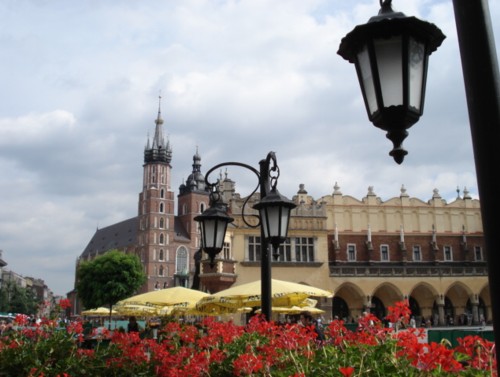
Design from Kraków’s main square with the Sukiennice Building and the Church of Mary
Distance
32 km V, 57 km SV, 133 km SE, 97 km SV, 41 km SE, 55 km SE, 75 km SV, 131 km NE, 376 km NE, 47 km NV, 144 km NV, 69 km NV, 102 km NE, 30 km SE, 111 km NV, 121 km SE, 126 km SE, NV, 64 km SV, 32 km SV, 79 km NV, 64 km NE, 69 km SV, 119 km NE, 112 km SE, 140 km SE, 25 km NV, 182 km E, 216 km NE, 60 km V, 75 km SE, 55 km SE, 240 km NV, 291 km NE, 58 km SV, 41 km N, 56 km SE, 144 km SE, 30 km S, 71 km NV, 25 km E, 106 km, 81 km S, 47 km SE, 61 km NV, 38 km NV, 178 km NV, 63 km V, 126 km SE, 83 km SV, 63 km S, 179 km SE, 125 km SE, 170 km E, 207 km SE, 16 km SV, 117 km SE, 54 km SV, 117 km SE, 87 km E, 40 km NV, 83 km V, 241 km SE, 46 km SV, 315 km NE, 15 km SE, 271 km NV, 81 km SE, 101 km S, 320 km NE, 45 km SV, 79 km NV, 93 km, 98 km SV, 88 km SVDistances in the area: Wadowice 46 sv, Sucha Beskidzka 54 sv, Maków Podhalański 58 sv, Skawina 16 sv, Kalwaria Zebrzydowska 32 sv, Chyżne (Slovak border) 94 sv, Oświęcim 63 v, Chrzanów 47 nv, Trzebinia 40 nv, Jaworzno 57 nv, Dąbrowa Górnicza 69 nv, Mysłowice 71 nv, Krzeszowice 25 nv, Olkusz 38 nv, Miechów 42 n, Proszowice 34 n, Niepołomice 25 ø, Wieliczka 15 Sun, Bochnia 41 Sun, Dobczyce 30 Sun, Myślenice 30 s, Rabka-Zdrój 63 s, Nowy Targ 81 s, Zakopane 101 s.
Population
758.000 (2004)
Location and history
Kraków. – Nowa Huta. – Tyniec. – Wieliczka
Kraków, the capital of Małopolska, has a population of approx. 758,000 and is a cultural, administrative and commercial center with a significant catchment area. In the city there is an old university and several other colleges. Kraków is located on the river Wisła’s upper race.
The first known document in which the name Kraków appears – and even three times – dates from the year 965. The text shows that at that time Kraków was a larger settlement, located around the Wawel hill.
The settlement, which was one of the centers in the area of the wislaner tribe (kraj wiślan), was given increased importance by the inclusion in Mieszko I’s state, not least after the creation in the year 1000 of a diocesan seat in this place. Kraków gained marketplace rights in 1257.
The archaeologists have shown that the Wawel mound was inhabited as early as the early Stone Age. The evidence for this must be different butterflies that can be seen today in the Archaeological Museum.
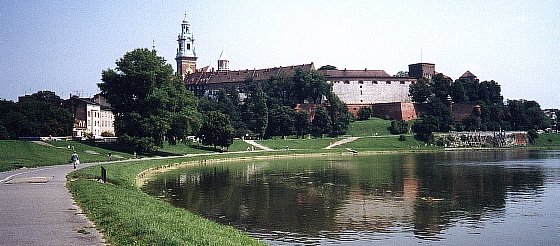
Wawel seen from the river bank northwest of the castle mound
Later, the residence of the Polish kings was built on the Wawel hill. Here the kings were also crowned, as is their burial ground; Kraków was the capital of Poland from the 11th to the 17th century. In 1364, Akademia Krakowska, the first higher education institution in Poland, was established (present name: University of Jagielloński).
The city developed a lot over the centuries. In the Middle Ages, it was a secure, rich fortress, surrounded by a wall of 47 towers, 6 of which served as the city’s defense gates.
Krakow’s building monuments originate from all time periods. The number is estimated at approx. 6 thousand. In addition, there are about 2.5 million works of art in the city’s museums, churches and archives. Based on this exceptionally rich collection of cultural monuments and works of art, Kraków is listed on UNESCO’s World Heritage List.
Krakow’s traditions
Many legends are associated with Kraków. Two of them are connected with the Tatars’ assault on the city in the 13th century.
From the tower of the Church of Mary is played at every hour and against all four corners of the world a trumpet on the trumpet. It is “Hejnał”, an alarm signal that is interrupted midway. According to legend, a janitor played the old tune from the windows of the church tower; he was pierced by one of the enemy arrows when he had played half the tune, but had then managed to warn the inhabitants of Kraków of the attacking Tatars.
In another legend, the colorful character Lajkonik appears. It was a raft of logs that, after the victory over the Tatars, dressed in a conquered Tatar suit, rode from the battlefield and into the city to tell the happy news of the victory over “disbelief”. Nowadays, on festive occasions, you can see a man disguised as Lajkonik “ride” around the main square in Kraków.
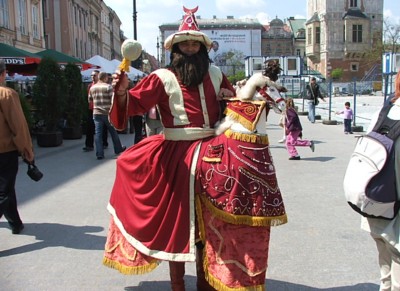
The Lajkonik figure on the main square in Kraków
On Saint Hans night, the shortest night of the year, residents of Krak’s old town gather at Wisła’s wide, as they have done over the centuries. With the majestic walls of the castle as a backdrop “Wianki”, an ancient pagan custom that states that young, unmarried women send flower wreaths down the river for signs of marriage. Outdoor performances are staged, fireworks are burnt etc.
Tourist attractions
Only in a few European cities can, as in Kraków, clearly see the medieval city plan with a chessboard of streets, which today, however, is only surrounded by fragments of the original defense walls.
In the Middle Ages, Kraków was a fortified city with defensive walls, which – reinforced by 47 defense towers – surrounded the city over a distance of 3 km. A total of 8 main gates led into the city; only one of these exists today.
The medieval defense system was in its entirety until the 19th century, when the city’s then authorities decided to demolish the walls. In their place arose Planty , one with respect to the form of unusual city park, which extends like a band from one side of Wawel mound , around the old town and back to Wawel.
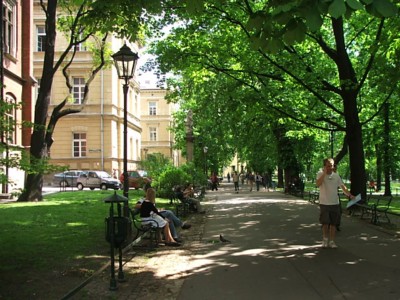
From the Planty City Park
Kraków was the capital of Poland until the 17th century.
“Kongevejen” through the city, beginning at the defense facility Barbakan , passed through Florian gate (Brama Floriańska), also called “Porta Gloriae”, along the Florian street to Main Square and from there on ul.Grodzka to the castle mound (Wawel mound), sometimes called it “Polish Acropolis”.
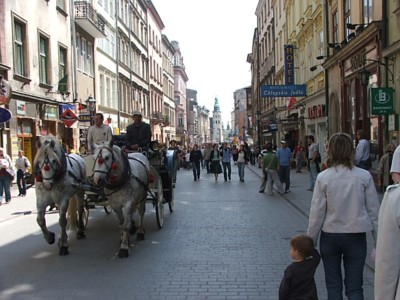
Ulica Grodzka
On the mound dominates Cathedral , coronation site and burial ground for the Polish kings, as well as the nearby royal castle , rebuilt in the Renaissance style, which has been the residence of kings of the Piast and Jagiełło dynasties as well as a single of the Vasa dynasties, namely the king who moved the capital from Krakow to Warsaw.
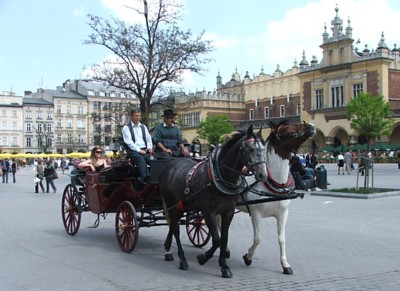
From the Main Square (Rynek Główny). To the right the Sukiennice building
Wawel Wawel is a ridge of limestone in the center of Krakow, on the Wisła River. The ridge, originally surrounded by swampy areas, attracted human settlement as early as the Stone Age. In the 9th year. became the Wawel center for the wislaner tribes. In connection with the creation of the Diocese of Cracow in the year 1000, the building of the cathedral on the Wawel Hill commenced. In the first half of the 11th year. There were early Romanesque buildings that included the authorities’ residency – ecclesiastical as well as secular.
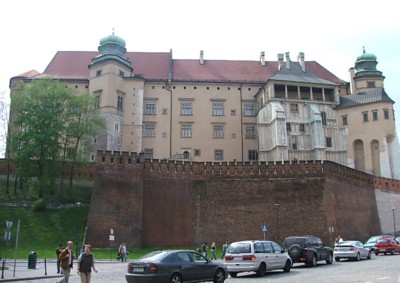
Wawel, seen from the east
In the years 1034-1058 Wawel became the headquarters of the Polish state authorities.
At the transition between the 13th and 14th centuries. the mound was surrounded by a defensive wall of stone instead of the previous violence of soil and wood. This created a clear separation between the upper castle, ie. the royal residence (on which it was built throughout the 14th century) and the lower castle which had service and business functions.
The period that was able to show the highest development of architecture and art on the Wawel hill fell under the rule of the Jagiellon, especially during Zygmunt the Old and Zygmunt August. In the years 1506-1534 the Gothic castle and residence palace were rebuilt in the Renaissance style and equipped with a magnificent courtyard with archways. In connection with the cathedral, the Royal Zygmunt Chapel (Kaplica Zygmuntowska) was built in 1519-1533 – a model example of great Renaissance art in Poland.
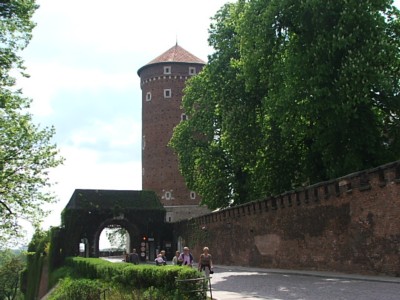
The access road to Wawel on the south side of the castle mound; th. for the gate is the Sandomierz Tower (Baszta Sandomierska, 15th century)
After the fire in 1595, part of the residence was rebuilt in the early Baroque style. The royal architect, Jan Trevano, who led the work, erected two towers at the castle’s northern wing: the Zygmunt III Waza Tower and the so-called Sobieski Tower. In 1655-1657 the castle was destroyed by the Swedish forces. However, the biggest disaster in the history of the castle was the fire in 1702. The fire – whose rise was due to the Swedish soldiers at the castle – devoured the castle’s Renaissance interior. the destruction continued after Poland’s split. In 1795, the Prussians stole the crown regalia that never came back.
For most of the 19th century. was the Wawel mound occupied by the Austrian army. The lower castle was destroyed as part of the buildings were leveled with the ground.
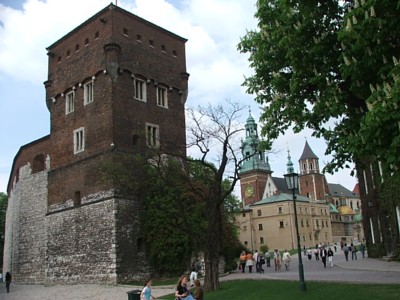
The entrance to the castle area from the southwest corner. Television is shown Baszta Złodziejska (The Twelfth Tower) from the 14th century, the cathedral
In 1846, Kraków was finally incorporated into Austria and converted into a fortress. Wawel was surrounded by a defensive wall with bastions; the fortifications erected in 1790-92 by Polish engineers were elevated. The royal castle and the priesthood seminary were built for military barracks. A large hospital building was erected in the southwest corner of the mound.
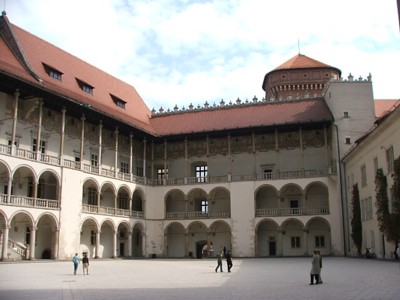
The courtyard at Wawel
During World War II, Wawel was the seat of the occupying forces under the General Government and Hans Frank. The building, which housed the so-called royal kitchen, and the Austrian hospital building were rebuilt. To the south, an entrance gate was constructed in 1942 (Brama Bernardyńska).
After 1945, one of the buildings, belonging to the Austrian hospital, as well as the Rehabilitation Center home was demolished and a new building erected on the site of the Royal Castle was erected on the site.
The Wawel Hill is a memorial to the nation’s past, consisting of several museum objects housed in the castle building and former royal kitchens. The permanent museum objects include the castle’s rooms, the royal treasury, the armory and the exhibition of war trophies, conquered by King Jan Sobieski’s victory over the Turkish army at Vienna in 1683. A special museum unit is made up of the Cathedral Museum.
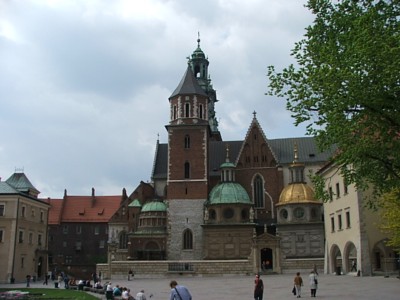
Cathedral on the Wawel Hill (Katedra Wawelska)
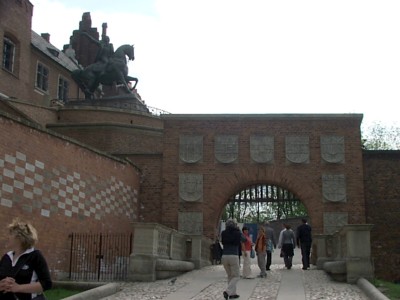
The access road to Wawel from the north through Brama Herbowa (Arms Gate). Television sees the statue of Tadeusz Kościuszko
Sigmunds (Zygmunt’s) clock
The most famous Polish church bell is located on Wawel, in one of the cathedral’s towers, and bears the name “Zygmunt”. It was a gift from King Zygmunt of the Old and was therefore named after him. It is cast by Hans Beham of Nuremberg. Beham received the king’s order on the bell in June 1520, and it was also cast this year, testifying to the year inscribed at the top of the bell: MDXX. The bell was hung in the tower – since called the Zygmunt Tower – on July 9, 1521 and on July 13, the bell sounded for the first time beyond Kraków. “Zygmunt” has a diameter of 2,424 m below and a height of 1.99 m. The thickness of the walls is between 7 and 21 cm, the volume is 1.2 cubic meters. The clock weighs 10980 kg. The metal composition is: 80% copper and 20% tin. The bell jam alone weighs 300 kg and to move it and ring the bell requires 8-10 people total effort.
Dragon cave
In the limestone cliff on which Wawel Castle is built, at the foot of the walls facing the river is the entrance to a cave called the Dragon Cave. One of the old legends about Kraków is – in different versions – about a terrible dragon who lived in this cave. The dragon continually demanded sacrifices of flesh, including human flesh, but it was eventually killed when the legendary hero made the sacrifice of a whole ox, stopped with sulfur, to the dragon. By the end of the 19th century. the cave was examined by A.Alth, who, however, found only skeletons of animals. In 1950, archaeologists near Baszta Złodziejska (Twelfth Tower) discovered a rock column and in 1960 another column that was artificially expanded. According to ancient tradition it is stated that in the interior of the Wawel cliff there are several caves and caves. They were used by poor people as housing. Today, no one lives in the caves, nor is there a dragon, but in memory of the legend’s dragon, a large sculpture, a dragon, made by a sculptor from Kraków, Bronisław Chromy, has been erected.
The total length of the underground caves is 270 meters and the maximum height is 10 meters. The distance that tourists can see is 80 meters long; it includes descent via a former well and three separate voids in the rock. In 1983, Krakow speleologists discovered another kite cave that is not open to visitors. Studies show that this cave has been used by humans since the 7th century.
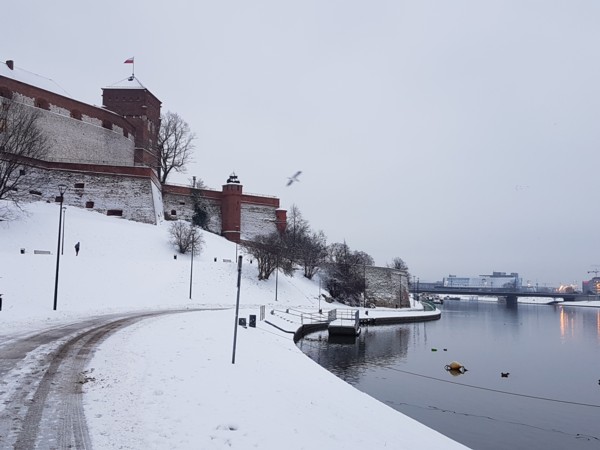
Wisła and Wawel in snow – Photo: Sylwia Dziedzina
Ulica Kanonicza (Kanikkegade)
is one of the most beautiful streets in Kraków. Previously, the street was part of the so-called Kongevej, which connected Wawel with Brama Floriańska (Florianporten). The name derives from the canoes of the Wawel cathedral that lived in the street. The most beautiful buildings in the street are built in the 16th century. The buildings with numbers 18 and 21 were owned by royal artists (Jan Michałowicz, Santi Gucci).
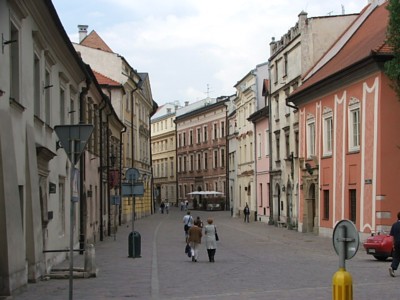
Ulica Kanonicza
Barbakan
Among the most valuable building monuments in Kraków are Barbakan, one of the best-preserved buildings of this type of defense architecture (advanced gate fortification) in Europe. It is located between Basztowa Street and Florian Gate and was originally built to secure the latter city gate. The Barbakan was built in the Gothic style in the years 1498-99 in connection with the Turkish threat. Via a bridge building, Barbakan was connected to the Florian Gate and was otherwise surrounded by a deep moat (up to 26 meters wide). The floor plan is semi-circular (6/10 of a circle); the building has a slab (total of 130) on 3 floors and is equipped with 7 small towers. The walls are approx. 3 meters thick. The building has two gates, one on the Kleparz side and one facing the Florian wall. The latter was created in the years 1839-1842 (after the demolition of the connecting building to the Florian Gate) in place of the Gothic tower of 1422. In front of the gate on the Kleparz side was a winding bridge over the moat which rested on four columns of stone and brick.
Florianporten (Brama Floriańska)
The city’s main gate, built at the end of the 13th century; exit Florianade to the north. By the end of the 15th century. was added at the top of a brick floor that included an advanced, enclosed balcony for defense purposes, resting on stone brackets. At the bottom of the balcony there are holes through which the enemy could be shot and otherwise fought (machicouli gallery). At the same time, a connecting bridge, a so-called “throat” between the gate and Barbakan (demolished in the first half of the 19th century). The Florian Gate was then the representative access road to the city and – via Kongevejen – to Wawel. Along with the gate are remains of the medieval city wall.
Sukiennice
Sukiennice (meaning Cloth Stalls) is a term for trade stalls with clothes, etc., usually listed on the town squares. Sukiennice in Kraków is a long market hall, built at the end of the 14th century. 1556-1560 (after a fire in 1555) a renaissance-style rebuild (GMPadovano, S.Gucci) occurred. In 1875-79 Sukiennice was rebuilt again and became a representative building for commercial and museum purposes. On the ground floor there are stalls / small shops with clothes, glass, ceramics, amber, souvenirs, etc., as well as a café. On the first floor are collections from the National Museum. In and around Sukiennice – situated in the middle of the main square – there is always a stream of tourists; Around the building are many flower stalls – as well as large flocks of almost empty pigeons.
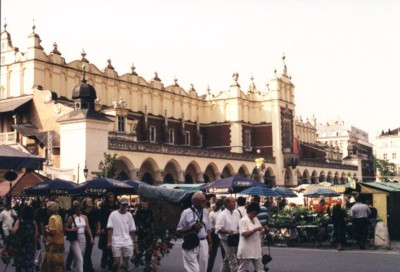
Sukiennice on Main Square
The building’s history dates back to King Bolesław the Venerable, who, when he resided in the city in 1257, undertook to build a marketplace – Sukiennice. In the beginning there was a street with stalls on both sides. At night, the wagons of goods drove into the street, closed at both ends with grids. In this way, a safe haven was created for the merchants and their goods. Based on these stalls, the building Sukiennice was gradually created. In the 14th century. the building was rebuilt and modernized by King Kazimierz the Great, resulting in a large three-ship edifice of 108 meters in length and 18 meters in width. From that time, the Gothic features originate in tower spikes and walls.
Sukiennice’s current appearance is mainly due to architect Tomasz Pryliński, who was responsible for the redevelopment in 1875-79. First of all, he built arcades on both sides of the main ship. The pillar heads were designed by Jan Matejko. In the first room a section of the National Museum was set up. The new Sukiennice was inaugurated October 3, 1879.
Sukiennice, one of the most famous buildings in Poland, serves not only commercial purposes. Large parties have thus been held on the ground floor. In 1787, King Stanisław August Poniatowski was celebrated by the city at a banquet for several thousand guests. In the review hall in the middle of the building, a knife hangs in an iron chain; the origin and meaning of the knife is not entirely clear, but according to. the legend has that connection to two brothers who built the towers of the Church of Mary; As one brother built one tower higher and more beautiful than the other, his brother killed him in anger with the knife, after which the killer committed suicide.
In 1883, the department of the National Museum was inaugurated in the beautiful rooms on the first floor of the building. At present there are exhibitions of Polish painting and sculpture from the second half of the 18th century. to the end of the 19th century.In the first floor you can see the art of Stanisław August’s painting, among others: M.Bacciarelli, P.Krafft, J.Ch.Lampi, J.Grassi, JPNorblin, K.Wojniakowski. The second floor contains pictures of the most famous painters of the Polish romantic period. In the third floor are works by artists such as: M.Stachowicz, WKStattler, Jan Matejko, J.Malczewski, T.Ajdukiewicz, J.Chełmonski. In the fourth floor are works by: H.Siemiradzki, A.Grottger, J.Kossak, J.Brandt, H.Rodakowski, M.Gottlieb, A.Gierymski, O.Boznańska, W.Podkowiński, J.Falat. In the fifth floor you can admire the art of painting from the Polish, Impressionist period.
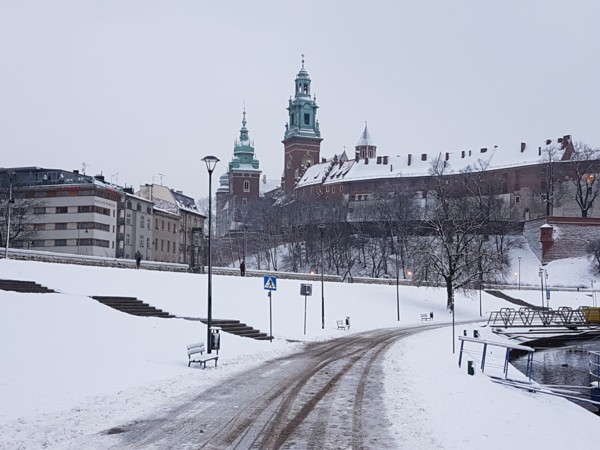
Wawel in winter – Photo: Sylwia Dziedzina
Town Hall Tower
The tower stands on the Main Square (Rynek Główny) and is one of the most famous architectural motifs in Kraków. It was erected together with the town hall at the transition between the 13th and 14th centuries. It is built in Gothic style and on the foundations of a former building on the site. Due to extensive destruction, the town hall itself was demolished in the first half of the 19th century. Thus the tower stands alone, which has a height of 70 meters; the tower has a slope of 55 cm in relation to a vertical line. In the basement under the tower and the former town hall, the town’s prison and torture chamber, as well as a beer hall, were for centuries. Today, the basement houses a stylishly decorated café.
In the tower itself is a branch of Kraków’s city history museum with exhibits illustrating the history of the city council. Facing Szewska Street, a new entrance staircase, adorned with stone lions, has been added from the Morstin family palace in Pławowice.
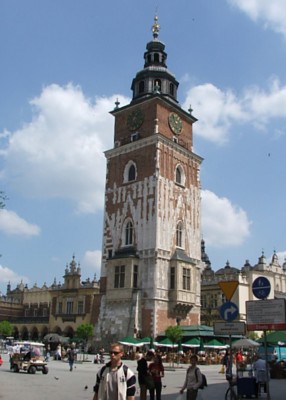
The old town hall tower
Jagiełło University (Jagielloński University)
The university is one of the oldest in Europe, founded in 1364 by King Kazimierz the Great. The representative university building, Collegium Maius, was built in the 14th-15th century. The building was built with a square floor plan and with an inner courtyard. The ground floor facing the inner courtyard is equipped with beautiful archways according to Italian pattern. Today, some of the rooms in this main building are used for representative purposes, while others accommodate the University Museum. The museum’s collections include astronomical instruments, as well as apparatus in physics and chemistry as well as ancient images and sculptures. – At Jagiełło University, Mikołaj Kopernik (Copernicus).
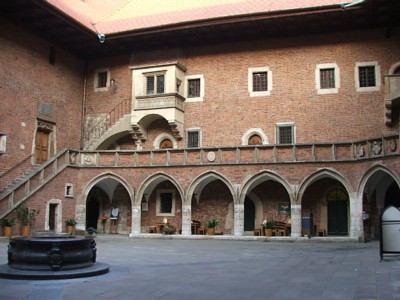
Collegium Maius, the oldest Gothic university building in Kraków
Church of Mary (Kościół Wniebowzięcia Najświętszej Marii Panny, Mariacki)
The Church of Mary (The Church of the Blessed Virgin Mary) is located at the Main Square (Rynek Główny), on the eastern side. The oldest Romanesque church was erected in the first half of the 13th century. The present Gothic building emerged in the 14th century. In the first half of the 15th year. page chapters were added. This remarkable, three-tiered church building is fitted with two towers. The tallest of the towers bears a beautiful Gothic dome with a baroque crown. This tower was the city’s watch tower, and from here you can still hear every hour “hejnał mariacki”, Kraków’s musical symbol.
The most valuable piece of furniture in the church is the famous altarpiece, made by Wit Stwosz in the years 1477-89 and honored as a gift to the church by the nobility and citizens of Kraków. This work, a five-winged altarpiece, represents the most outstanding artist in the art of the Gothic church in Europe, and especially in the case of altarpieces of the closet type. On the board we see a large number of scenes of the life of Mary and Christ with 200 figures, all carved in lime tree.
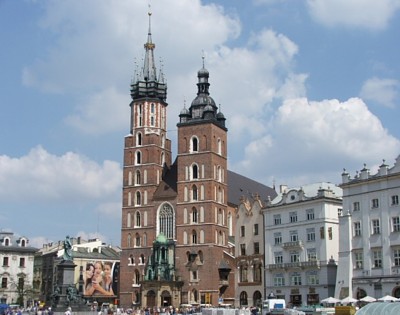
Maria Church
In the windows of the Presbytery are the beautiful 14th-century mosaic tiles. preserved. The interior of the church is decorated of a work in polychromy, performed by Józef Mehoffer and Stanisław Wyspiański and others. after draft by Jan Matejko. Also noteworthy are the 17th-century chandeliers, which are decorated with carved scenes from the New Testament. Richly ornate altars, especially in Baroque style, stand in the side ships and side chapels. There are also valuable paintings by Szymon Czechowicz and Dominik Estreicher. Next to a stone crucifix by Stwosz is a magnificent Renaissance-style ciborium (hostie gem), a work by an Italian artist: Jan Maria Padovano. Among the numerous memorials and epitaphs of citizens of Kraków should be highlighted: the bronze plates of the genera Solomon and Boner as well as the headstones of the Montelupi and Cellari families.
Anna Church
St. Anna’s Church is located at ul. Św. Anny. The first wooden church arose on the site in the 14th century. In the first half of the 15th year. erected – after a fire – a Gothic-style brick church, funded by King Władysław Jagiełło. The present church, after the demolition of the Gothic building, was erected in 1689-1703, funded by Akademia Krakowska and projected by Tylman van Gameren. It is one of the most beautiful Baroque buildings in Poland. The interior of the church is adorned with sculptures and architectural masterpieces (including the altar) by Baltazar Fontana and paintings by Karol Dankwart.
The Holy Wojciech’s Church
The Wojciech Church (Latin: Vojtechus) stands on the southern corner of Main Square. The oldest wooden church in this place dates from the transition between the 10th and 11th centuries. The present Romanesque-style building, a one-stone stone church with a square choir building, dates from the early 12th century; however, it was partially remodeled in Baroque style during the 17th-18th centuries. In the basement below the church is an archaeological museum with exhibits on the history and development of the Main Square, including the history of this church.
St. Peter’s and St. Paul’s Church
The church, located at ul.Grodzka, was built in the years 1597-1619 for the Jesuits, funded by King Sigmund Vasa (Zygmunt III Waza). It is a single-storey Baroque building with half-round choir building. On each side of the main ship are a number of chapels. The church’s interior altar, made in 1735, must be highlighted in particular from the interior of the church.
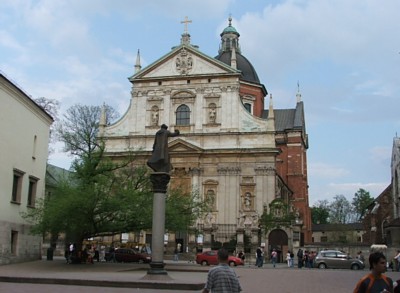
Church of Saint Peter and Paul (Kościół św.Piotra i św.Pawła)
St. Andrew’s Church
The church, located at ul.Grodzka, is in Romanesque style and one of the oldest buildings in Kraków. It was built at the end of the 11th century. and remodeled in the 13th century. The building is the wooden ship with half-round chancel building and two towers to the west. The church also includes the Clarissa Sisters Monastery (built c.1325), where there are large numbers of religious works of art and relics.
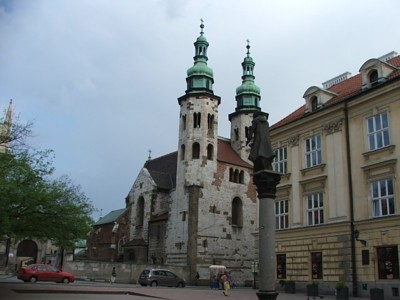
St. Andrew’s Church (Kościół św.Andrzeja)
Franciscan
The Franciscan Order came to Kraków from Prague in 1237. Their brick church (by Ul.Franciszkanska) in the early Gothic style was consecrated in 1269. In the 14th century. began the construction of the associated monastery. The church building was extended in the 15th century. The church is the burial ground of Krakow Prince Bolesław the Venerable and his sister Salomea.
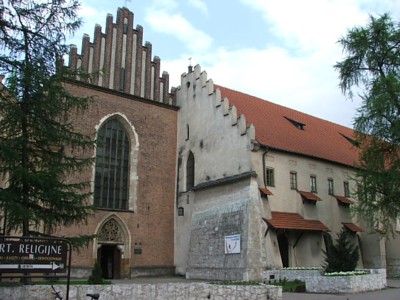
Franciscan Church (Bazylika oo. Franciszkanów)
The Church of the Holy Trinity (Church of the Dominican Order) and the Dominican Monastery
located at Plac Dominikański. There was a Romanesque church very early in this place. In 1222, the bishop of Kraków transferred the church to the Dominican Order, summoned from Bologna, Italy. Order began the construction of a monastery and – following the Tatars’ attack – a new Gothic church building, ie from the end of the 13th to the end of the 14th century.
The monastery is one of the largest in Poland.
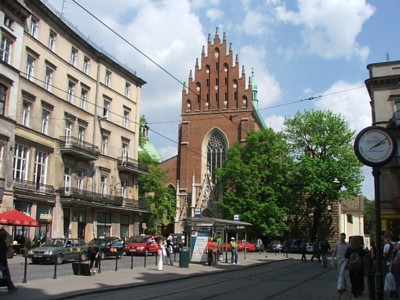
Church of the Holy Trinity (Kościół św.Trójcy / Bazylika oo. Dominikanów)
Holy Cross Church
at ul. Św. Krzyża is a Gothic tower with a tower built in the 14th and early 15th centuries. Of the church’s furniture, highlights the valuable Gothic triptych from about 1517, the crucifix from 1520, the Lothian crusades and the pulpit.
Pauline Church and Pauline Monastery
The church is the wooden ship and from 1751. From the 2nd half of the 19th century. is the crypt burial ground for many prominent Poles.
Church of Saint Catherine
at ul. Augustiańska, was donated in 1363 by King Kazimierz the Great to the Order of Augustine. It is an example of the Kraków School of Gothic Architecture, including characterized by a midship that is significantly higher than the side ships and by the simultaneous use of boulders and bricks in the building. Thus, boulders were used for the decorative elements of the building.
Bernardinerkirken
The first church was built in wood in 1453. The present church was built 1659-80 as a three-baroque-style building.
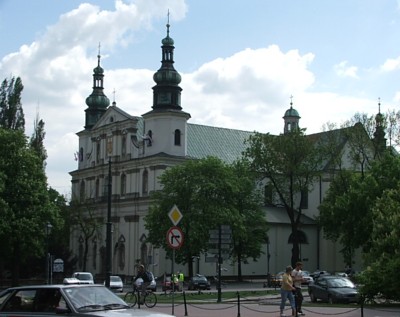
Bernadinerkirken
Kazimierz – Kraków’s Jewish quarter
is located just south of the Old City. The first Jews settled in Kazimierz in the second half of the 14th century. For this, Jews who had been displaced from other countries sought refuge. There were synagogues, Jewish schools and printing houses. Many Jewish intellectuals lived and worked here.
By the end of the 18th century. – after Poland’s split – the Austrian authorities issued an order to transfer all Jews from all over Krakow to Kazimierz, which “Jewish ghetto” was first introduced in Kraków. In 1930’after Hitler’s takeover of power, Jewish refugees from Germany also arrived in this district. At the outbreak of World War II, there lived about. 64,000 Jews in Krakow, ie about 25% of the total population. After the war, only a few Jews returned to Kazimierz.
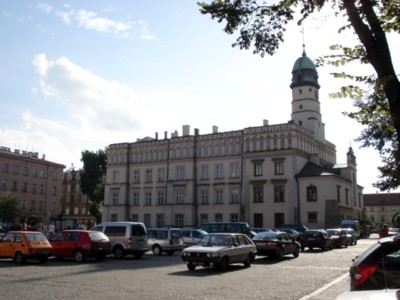
The former town hall of Kazimierz. The building now houses the Ethnographic Museum
The Jewish district of Kazimierz was a center of Jewish culture throughout Poland, but its significance also extended far beyond the country’s borders. It can be said that Kazimierz was for some time a Jewish capital of the world.
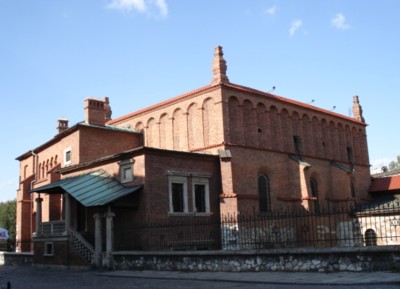
The old synagogue in Kazimierz – the oldest sacred Jewish building in Poland; erected in the 15th century, rebuilt after the destruction during World War II. Now museum of Jewish history in Krakow
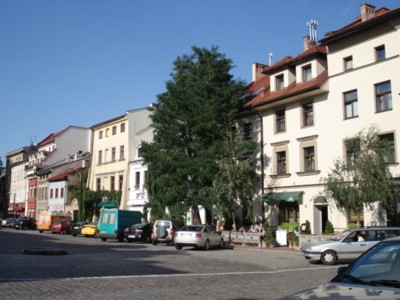
Kazimierz. east side of ulica Szeroka
Today, tourists in this district can see Jewish synagogues, theaters, schools, cemeteries and the Jewish community administration building.
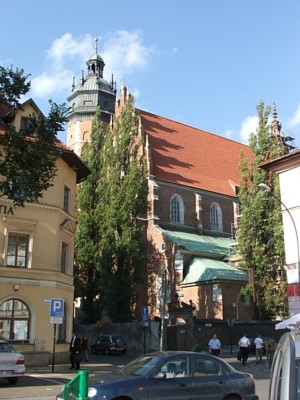
Church of the Body of God (Kościół Bożego Ciała) in Kazimierz, seen from Wolnica Square
Nowa Huta – Krakow’s largest district
Nowa Huta – approx. 10 km east of the Old Town – today considered part of Krakow, but was originally planned as an independent city. The population today is approx. 220,000. The city was built from 1948 and was to accommodate housing and all other urban amenities for the staff of the simultaneously erected huge steel mill on the site (Lenin Works / Huta im.Lenina), where iron ore from the Soviet Union was to be processed. The steel mill is today called Huta im. T.Sendzimira. In addition to this, the city houses large tobacco factories and cement plants.
The city was planned and built in a very short time. The town plan evokes memories of the baroque planning of entire cities. From a round, central square, 5 streets are removed as radii. The whole planning of the city as well as the realization of individual parts, thus the building of the central space, the use of colonnades etc. became one of the most significant examples of the construction art of the period of socialist realism.
Tyniec
is a small suburb southwest of the city center, on the Wisła River, known primarily for the old fortified Benedictine monastery, located on the high bank facing the river. From the fortified monastery, in the Middle Ages, access to Poland’s main city was controlled through the river valley from the southwest. The monastery, dating from the 11th century, was naturally protected and difficult to occupy with its location. Yet it was burned down by the Mongols in the 12th century, by the Swedes in the 17th century. and by the Russians in the 18th century. Benedictine monks have lived and worked in the monastery for nearly a millennium. Only a little is preserved by the monastery building from the 11th century. It was first replaced by a Gothic building, then – in the 16th century. – of a Renaissance-style building. The present Baroque-style monastery dates back to the early 17th century. You enter the monastery through an impressive gate that opens every day before 5 o’clock. In the church you can hear the monks singing in Latin every day during the service at 17.
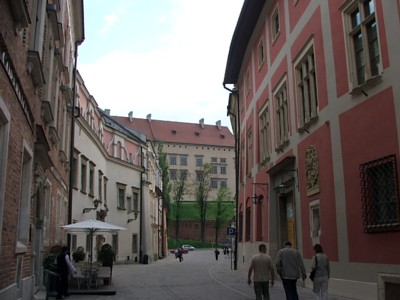
Ulica Kanonicza seen to the south; in the background, Wawel is seen
Museums in Krakow
Museum Historyczne Miasta Krakowa , Rynek Główny 35
Krakow City History Museum
Muzeum Historyczne Miasta Krakowa, Oddział Dzieje i Kultura Żydów Krakowskich , ul. Szeroka 24
Krakow City History Museum. Department of Jewish History and Culture in Kraków
Museum Historyczne Miasta Krakowa, Oddział Dzieje Teatru Krakowskiego , ul. Szpitalna 21
Krakow City History Museum. Department of Theater History in Kraków
Muzeum Historyczne Miasta Krakowa, Oddział Walka in Męczeństwo Polaków , ul. Pomorska 2
Krakow City History Museum. Department for the struggle and martyrdom of the Poles
Muzeum Historyczne Miasta Krakowa, Wieża Ratuszowa , Rynek Główny 2a
Krakow City History Museum. Town Hall Tower
Wawel
The museum at Wawel, see above under the section on Wawel
Muzeum Narodowe , Gmach Główny, al. 3 May 1
National Museum. The main building
Muzeum Narodowe, Dom Jana Matejki , ul. Floriańska 41
National Museum. Jan Matejko’s House (Polish painter)
Muzeum Narodowe, Muzeum Stanisława Wyspińskiego w Kamienicy Szołayskich , ul.Szczepańska 11
National Museum. Museum of Stanisław Wyspiański (Polish poet and visual artist) in the Szołayski Building
Muzeum Narodowe, Sukiennice , Rynek główny 1-3
National Museum. Department of Polish Art from the 19th century. in the Sukiennice building on Main Square
Muzeum Narodowe, Muzeum Książąt Czartoryskich , ul. św. Jana 19
National Museum. Czartoryski Principal’s Museum
Dworek Jana Matejki , ul. Wańkowicza 15
The Polish painter Matejko’s museum.
Muzeum Archeologiczne , ul. Poselska 3
Archaeological Museum
Muzeum Etnograficzne , pl. Wolnica 1
Ethnographic Museum
Muzeum Geologiczne , ul. Senacka 3
Geological Museum
Muzeum Historii Akademii Górniczo-Hutniczej , ul.al. Mickiewicza 30
Historical Museum of the Academy of Mining and Metallurgy
Muzeum Historii Fotografii , ul. Józefitów 16
Museum of Photography History
Muzeum Historii Armii Krajowej , ul. Bosacka 13
Museum of the Polish Home Army History.
Muzeum Farmacji , ul. Floriańska 25
Pharmaceutical Museum
Muzeum Archidiecezjalne , ul. Kanonicza 19
Archdiocese’s Museum
Muzeum Pamięci Narodowej , pl. Bohaterów Getta 18
Museum of National Remembrance
Lotnictwa Polskiego Museum , eel. Jana Pawła II 39
Museum of Polish Aviation
Muzeum Przyrodnicze PAN , ul. św. Sebastiana 9
Natural History Museum under the Polish Academy of Sciences
Muzeum Teatru Starego im. Heleny Modrzejewskiej , ul. Jagiellońska 1
Helena Modrzejewska Museum of Ancient Theater History
Muzeum Ukraińskiej Sztuki Sakralnej , ul. Paulińska 28
Museum of Ukrainian Church Art
Muzeum Uniwersytetu Jagiellońskiego , Jagiellońska 15
Jagiełło University Museum
Muzeum Ubezpieczeń , ul. Dunajewskiego 3
Insurance History Museum
Muzeum Zoologiczne , ul. Ingurdena 6
Museum of zoology
Center Sztuki in Techniki Japońskiej “Manggha” , ul. Konopnickiej 26
Center for Japanese Art and Technology “Manggha”
Center Kultury Żydowskiej
Center for Jewish Culture
Ośrodek Muzealny PTTK , ul. Westerplatte 15
Museum center under PTTK (Polish Society for Tourism and Home Learning)
Regional Museum Młodej Polski , “Rydlowka”, ul. Tetmajera 30
Regional Museum that illuminates the literary and artistic group and epoch Młoda Polska from the transition between the 19th and 20th centuries.
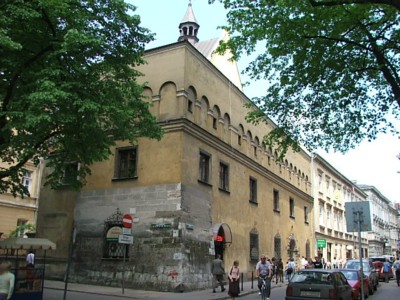
Ulica Wiślna seen from Planty towards the square. TV. the extension (with porch) to St. Norbert’s Church (Kościół św.Norberta), built 1636-43
Surrounding Area
Kraków is located in the Wisła River Valley. To the northwest of Kraków there is a hilly terrain with white rocks from the Jurassic era, the so-called Jura Krakowsko-Częstochowska. The Wawel Hill forms the beginning of this rocky landscape extending northwest across Ojców, Olkusz and Ogrodzieniec to Częstochowa.
Immediately south of Kraków begins a heavily hilly landscape, further south to the actual mountains, belonging to the Beskidy mountain range.
Wieliczka
About 15 km southeast of Krakow lies the small town of Wieliczka. The city was founded in 1290. The main tourist attraction – and the reason why the city’s name is world famous – is Muzeum Żup Krakowskich, ie. Salt Mine Museum. This museum, one of the largest mining museums in Europe, is located in the underground excavations and covers the mining of the over 700-year-old salt mine. In 1978, the mine and museum were erected at UNESCO’s list of the world’s cultural and natural heritage. In 1994, the museum was recognized as a historical memorial by the Polish president. The salt mine consists of a 200 kilometer long maze of corridors, located on nine levels. The mine measures 327 meters in depth and the maze’s corridors connect a total of approx. 2000 chambers.
See the independent page about Wieliczka with photos and links.
Krzeszowice .
*See the independent page about Krzeszowice , including about the Monastery of Czerna and the castle of Tęczyn in Rudno
Ojców National Park
with the castle Pieskowa Skała lies approx. 20 km to the northwest.
See the independent page about Ojców National Park
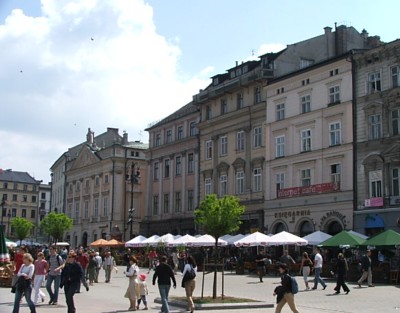
Design from Hovedtorvet
Accommodation
Booking.com
Krakow:
General links regarding Accommodation in Kraków:
Magiczny Kraków (Polish, English, French, German, Russian, Spanish and Italian). – with practical information for tourists, including accommodation.
Surroundings:
Bed & Breakfast
Maków Podhalański
Eating Out:
Magiczny Kraków (Polish, English, French, German, Russian, Spanish and Italian). – With practical information for tourists, including eateries
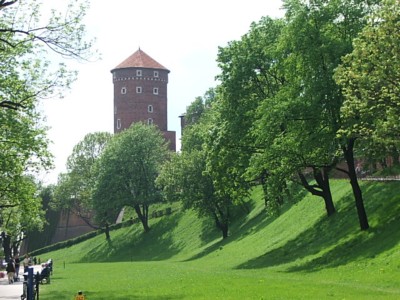
The southern slope of the Wawel castle hill
Other Internet sites and sources
Magiczny Kraków (Polish, English, French, German, Russian, Spanish and Italian). Here you will find a very comprehensive sub-page about tourism, both attractions, modes of transport, culture, accommodations, city maps, the Kazimierz and Nowa Huta districts and much more.
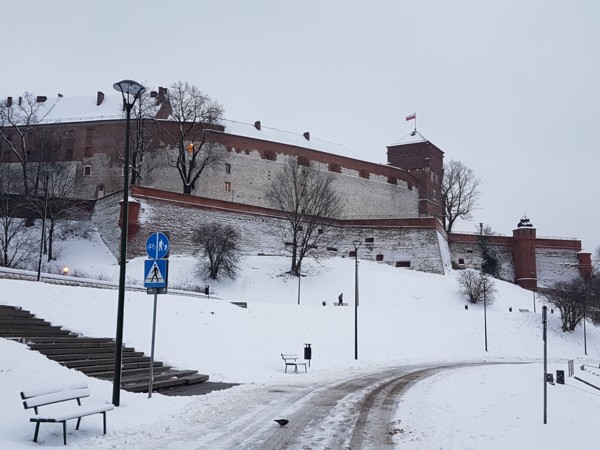
Wawel dressed in snow – Photo: Sylwia Dziedzina
Translated into English by Google Translate. Spangshus.dk accept no liability for any errors or omissions in translation.
Map

Rating
Search
Most used tags
churches (205) Castles (86) Monasteries (79) Town walls (74) Lakes (71) Town halls (67) Rivers (65) Castles1 (62) Mansions (55) Museums (51) Regional museums (38) Town gates (36) Abbey churches (35) Castle ruins (30) Cathedrals (26) Forests (25) Health resorts (24) Mounds (23) Water sports (23) National parks (22)Click for all tags
Denne side er også tilgængelig på dansk. This page and contents is (c) Copyright 2018- www.spangshus.dk. Based on Inviator software by ISCA Software